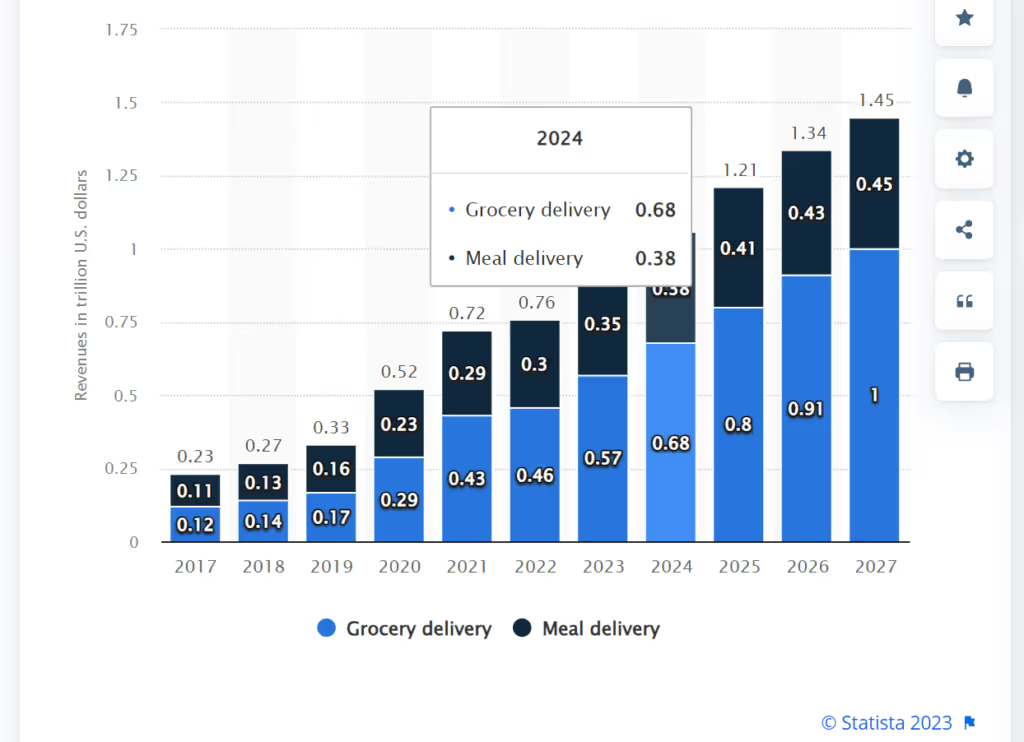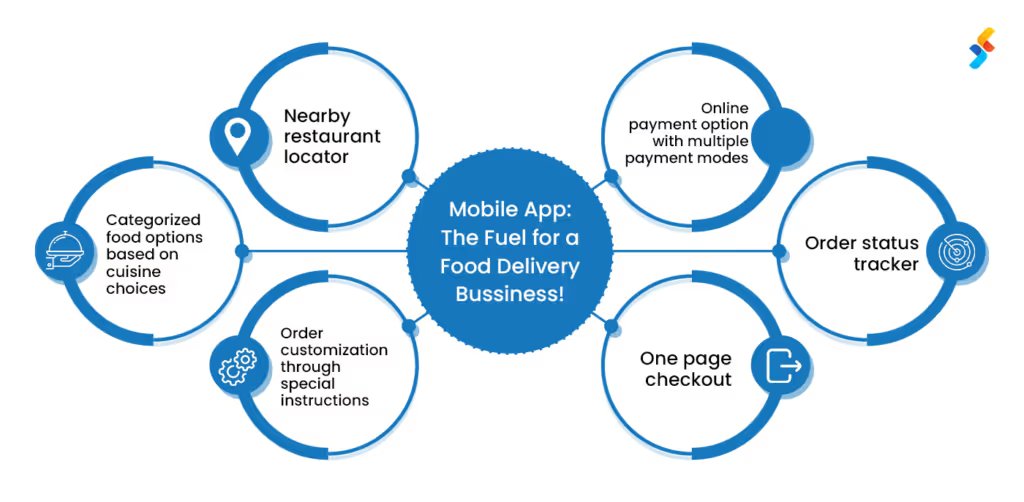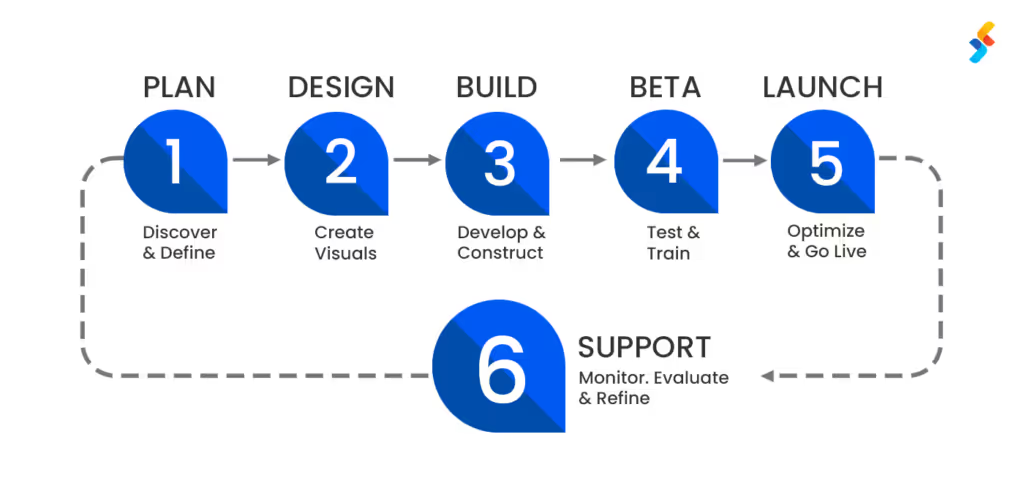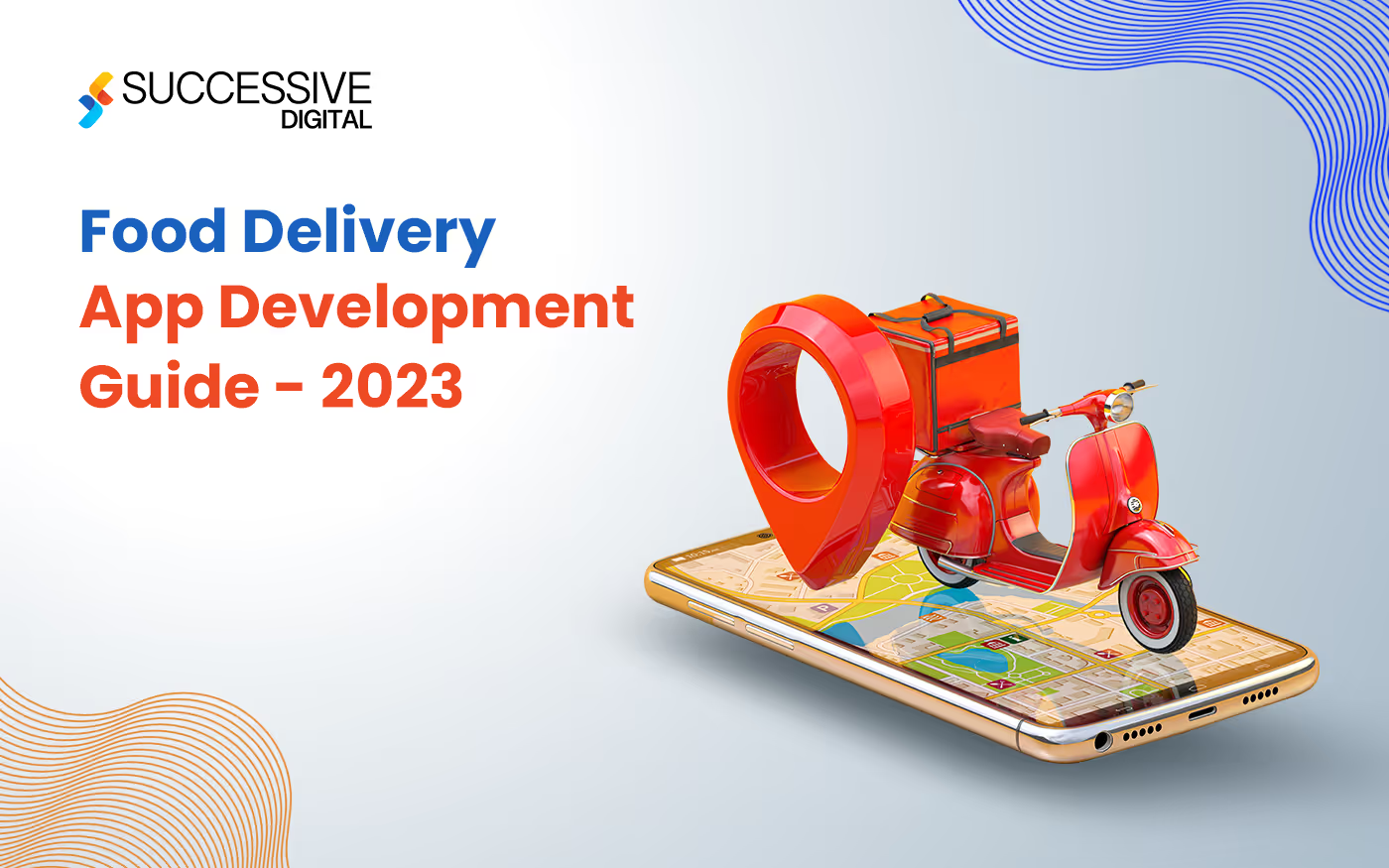Over the past few years, door-to-door delivery services have expanded, unveiling different dimensions by profiling smartphone users, internet access, and IT enforcement in the sector. And in this industry vertical, food delivery applications are becoming increasingly popular.With the rising demand for online food delivery and market opportunities in this sector, it is the right time to invest in food delivery app development.Do you want to know how to build a food delivery app? Understanding the market strategies, technologies, and app development cost is essential for developing a successful food delivery app.
On-Demand Food Delivery App Development: Why Do You Need It?
Online food delivery apps have changed people’s day-to-day lives drastically. With the convenience of food delivery apps, people can taste the food from their favorite restaurants or hotels from anywhere. Hence, these apps generate lucrative opportunities for hotels, consumers, and restaurants in the food industry.
The Potential to Flourish in the Future
Did you know food-delivering apps such as DoorDash generated over $6.58 billion in 2022, growing 34% from the previous year? This revenue number continues to rise, with 32 million monthly customers across 25 countries.The online food delivery app market is continuously growing and is expected to generate 1.4 trillion U.S. dollars by 2027, recorded at 770 billion U.S. dollars in 2022.Online Food Delivery Market Revenue Worldwide (From 2017 to 2027 in trillion U.S. dollars)

Therefore, your business requires a food delivery app to revolutionize traditional methods.
Setting-up Virtual Kitchen
Food delivery app development provides your business with a unique opportunity to set up virtual restaurants. Businesses exclusively focus on creating seamless food delivery models to gain potential customers through online food delivery.
More Customer Retention
With a food delivery app, you can effectively engage with your customers via push notifications, messages, or email. You can update them about the loyalty programs, the latest discounts, and real-time offers. Moreover, you will be able to build a more prominent brand presence for your business and reach a wide range of audiences, leveraging the popularity of mobile devices.
Resolving Location Constraints
By creating a food-delivering app for your restaurant, you can serve your customers beyond a particular geographical area. Moreover, you will not have to spend commission fees or delivery charges by connecting with aggregator models like GrubHub or Foodpanda.
What are the Successful Online Food Delivery Apps in 2023?
Types of Food Delivery App Business Models
Once you complete all the groundwork related to your food delivery app development, you need to turn and select the most appropriate app model to begin your food app development journey.
Restaurant-to-Consumer Model
In this model, users can directly order food from the restaurant app, such as Domino’s, McDonald’s, Chick-fil-A, KFC, etc. The restaurant is responsible for preparing and delivering the food to the customers at their location. This type of food delivery business model suits a restaurant with its own riders/delivery partners.
Platforms to Consumer Model
This is one of the most popular food delivery app models that onboard many restaurants on a single app platform. In this model, the platform handles the delivery process. This is a popular model as you can charge delivery fees and order commissions from restaurant partners.For instance, Uber Eats and DoorDash.
Food Delivery Aggregator Model
The aggregator model combines the above two food delivery app development models. Here, the restaurant partner is responsible for delivery services and only uses the app to get orders. For instance, Domino’s uses food delivery apps to get orders but handles delivering the food to the customers with their own riders, taking charge of the customer serviceExamples: GrubHub, JustEat, or Delivery Hero.
What are the Must-have Features for Food Delivery App Development?

A food delivery app also accommodates the convenience of fulfilling online orders for people, restaurants, and delivery partners. These applications have four types of users.First, a panel for a consumer. Second, a panel for restaurants. Third, a panel for delivery partners. Fourth, an admin panel or a panel for application/platform owners. Therefore, we can categorize app features in every head, such as:
Food Delivery App Development: User Panel Features
After successfully installing the online food-delivery app from the Google Play Store or Apple App Store, customers are required to provide the necessary details in order to place their food orders from the app. You must develop the following features in the user panel to allow them to do so.
- Login: Users can manually enter their email address and password or conveniently log in through social media platforms like Facebook, Instagram, and Gmail. Alternatively, they can receive a one-time password (OTP) confirmation on their mobile number for authentication.
- Location: While users have a list of nearby restaurant options, they can also explore the map to select their preferred restaurants or locations.
- Homepage: The homepage, or the user’s dashboard, contains comprehensive information about each restaurant. Apps like Uber Eats and Postmates display well-organized details to avoid overwhelming users with excessive information.
- Menu: The menu is a critical feature of on-demand food delivery apps. Once a user selects a restaurant, they will be shown a menu comprising a variety of food options along with images, user reviews, estimated delivery time, contact number, and more.
- Food-Delivery Pickup Location: Users can enable GPS for automatic address recognition, manually input their address, or directly set their pickup location on the map.
- Shortlisted Items: This section allows users to create a shortlist of food items that can be modified before finalizing the order. Users can adjust the quantity by tapping the increase and decrease buttons next to the food picture.
- Payment Modes: Once the items have been finalized, the next step is to proceed with the payment. Users are presented with various payment options, such as debit card/credit card, net banking, cash on delivery, or available payment gateways. Confirmation of the order is sought on this page.
- Feedback And User Reviews: Users can access reviews and feedback to make informed decisions before placing an order.
- Offers, Discounts, And Deals: The restaurant owners regularly update users through push notifications regarding ongoing discounts and offers on their food items.
- Contact Information: Detailed contact information, including the restaurant’s contact number and address, is provided to users for the restaurant where they have placed their order.
- Track Your Order: Users can conveniently track their order in real-time and access information such as estimated arrival time and the option to make a one-tap call if needed.
- Search: The search feature is essential for on-demand app development for food delivery and is typically located at the top of the home screen or user’s dashboard. Users can easily search for their favorite restaurants or specific food items they wish to order.
- Refine Search: Users have the ability to filter their food item search based on delivery time, reviews, prices, offers, and discounts.
Food Delivery App Development: Restaurant Panel Features
Restaurant owners need to follow a similar login and registration process within the app, they are required to provide additional documentation to verify the authenticity of their business.Dashboard: Upon setting up their account, restaurant owners are directed to their homepage or dashboard. This page allows them to track the number of received, pending, and completed orders. They can access detailed information about each order, including its specific details.Order Details: This feature is important in food-delivery apps' restaurant panels. Restaurant owners can decline orders they cannot fulfill, such as when they don’t provide home delivery or have a particular food item unavailable, based on their feasibility.Account Management: Each restaurant has the flexibility to manage its app account according to its preferences. They can upload pictures of their restaurant, name, logo, food images, minimum order quantity, delivery charges (if applicable), and operating hours. Additionally, they can showcase ongoing offers and discounts.Payment: In this section, owners can provide users with payment options such as direct transfer to the owner’s account, PayPal, or wallet integration.
Food Delivery App Development: Partner Panel Features

Like the other two panels, the delivery panel also requires a quick login and registration process. The delivery panel application comprises the following features:Login: Delivery personnel receive their login credentials from the Admin to use the application.Order Request: When a customer places an order, it is automatically assigned to the delivery personnel along with essential details such as the customer’s name, address, and order ID.Food Order Delivery Status: This section enables restaurant owners and customers to track the order status on their respective screens. They can monitor whether the order is delivered by the delivery personnel or is being prepared.Order History: Delivery personnel can review their delivery history, including orders they have successfully completed and those that are still pending.Payment Via Wallet/Offline: The Admin pays the delivery personnel monthly or weekly for their food deliveries. The payment can be received either in the form of an eWallet or directly into their bank account.Google Map Navigation: Delivery personnel utilize Google Navigation to accurately navigate to the exact location of the food order delivery.
Food Delivery App Development: Admin Panel Features
An admin panel usually refers to the person who owns the application or platform. This panel is the most important one as the admin can track the well-being of the business, implement and integrate new business functionalities, improve user experience, and others. Top features usually integrated into the admin panel besides having access to the other three panels include:Data Control: With the help of a dashboard, an admin can look at and control all the data that is taking place within the application. Be it a user list, active users, add new users, or may edit/remove users. This panel also comprises all the details and the number of listed cinemas, movies, total booking, total earnings, and so much more. From this place, an admin can also manage shows and venues.Add/Block Feature: Just like the option to manage user profiles and choose to add/delete/edit users. Add/Block Feature allows admin to manage offers provided. He/she can add/delete/block/edit features such as promo codes, coupons, etc.Usage Analytics: This feature allows the admin to review the real-time actions of the user’s search journeys. It helps the admin collect, analyze, present, and visualize data for increased user engagement, product life-cycle, and more. The rich usage analytics help admin in the following way:
- Understanding user behavior that gives admin context to improve user adoption.
- Observe content requirements if gaps are available.
- Keep an eye on the best content and optimize the relevance of search results for more capabilities.
Tech Stack for Food Delivery Application Development
For a successful on-demand food delivery app development, it is essential to know the technologies behind highly successful apps such as DoorDash and Uber Eats.Here is a list of tech stacks to help you select the suitable technologies.
Step-by-step Process for On-demand Food Delivery App Development
You must focus on a well-thought-out plan and hiring an experienced food delivery app development company. The app should be based on a unique idea that solves a real problem and meets the needs of customers and business owners alike.By following the steps below, you can create a successful food delivery app that meets the market's needs and stands out from the competition.

Understanding The Market And Identifying The Problem
Food delivery app development requires a deep understanding of the market and the problems that customers and businesses face. The first step in the process is to conduct thorough research to identify the gaps in the market that your app can fill. This involves analyzing the competition and understanding their strengths and weaknesses. You should also gather customer behavior and preferences data to identify the features customers value most.After identifying the problem, you should create a detailed user persona to understand your target audience. You should also consider the business model and revenue streams that will make your app profitable.
Creating The App Concept And User Journey
With a deep understanding of the market, the next step is to create a concept for your food delivery app. This involves defining the app’s core features and functionalities and mapping the user journey. You should also consider the app’s branding and visual identity, ensuring it aligns with your target audience’s preferences.The user journey should be intuitive and easy to navigate, ensuring that customers can quickly and easily place an order. To better understand the user journey for a mobile application, you can discuss your challenges with a mobile app design company. They will help you identify and consider the user interface (UI) and user experience (UX) design, ensuring the app is visually appealing and easy to use. The design should be consistent across all screens and align with the app’s branding and visual identity.
Developing The App
With the app’s design finalized, the next step is to start development. This involves coding the app’s functionality and integrating all the required features. The app should be optimized for performance, ensuring it loads quickly and runs smoothly.You can begin food delivery app development with MVP products. An experienced MVP development company can build your application with minimal features and functionality that you can launch within the market with real users. Based on their feedback, you can further optimize your app and integrate features for better user acceptance and experience.
Testing The App
As the app is being developed, it should be regularly tested by a reliable software testing company to identify/debug any bugs or issues. Testing should be done on different devices and operating systems to ensure the app is accessible to a wide range of customers. You should also conduct user testing to gather feedback on the app’s functionality and user experience.
Launching The App
Once the app has been developed and tested, the next step is to launch the app. The launch should be well-planned and executed, ensuring that the app is introduced to the market in the best possible way.
Managing And Updating The App
After launching the app, it should be regularly monitored and updated to ensure that it remains relevant and meets customers' needs. You should regularly collect customer feedback to identify areas for improvement and new features that could be added. Updates should be regularly released to fix bugs and improve the app’s functionality.
How Much Does it Cost to Develop a Food Delivery App?
On average, a primary food delivery app with essential features can cost anywhere from $20,000 to $50,000. However, if you require more advanced functionalities such as real-time order tracking, in-app chat support, loyalty programs, and restaurant management systems, the cost can range from $50,000 to $100,000 or more.It’s important to note that these figures are just estimates, and the final cost can differ based on your specific requirements and the food delivery app development company you choose to work with. For an accurate cost estimate, connecting with companies providing food delivery app development services and discussing your project in detail is highly recommended.Food delivery mobile app development cost varies from platform to platform as iOS and Android are the leading app development platforms. Here are the factors affecting the cost of building a food delivery app.
- App Design: The UI and UX design complexity also influence the cost of mobile app development for food delivery. A seamless UI and UX yield many tangible benefits for the app in the long run.
- Project Scope: After an idea of the project's scope and the complexity of the business logic, you will be able to collect the right cost estimate to build a food delivery app.
- Developer Cost: The developer’s geographic location and the level of expertise and experience also add to development cost.
- Mobile Wallet: In online food delivery app development, it is essential to add multiple payment gateways, including credit/debit cards, PayPal, and Amazon Pay, influencing the food delivery app development cost.
How to Monetize a Food Delivery App?
Monetization is one of the crucial factors of the food delivery app business model. If you are stepping into entrepreneurship with food delivery app development, you should know how you will make money or profit from the online business.Understanding that food delivery app owners have multiple avenues to generate revenue is essential. Typically, they combine (or sometimes all) the four methods we describe further.
Delivery Fees
Charging for deliveries is a primary method for food delivery app development service providers to generate revenue. However, this applies specifically to those whose business model encompasses managing both orders and deliveries, such as Uber Eats or DoorDash. Essentially, this involves the customer paying a fee for their food delivery.Some platforms employ a fixed rate, while others adjust the charge based on the distance the driver needs to travel. Delivery charges are beneficial for establishing a consistent income stream, but they are typically insufficient to sustain a business on its own. Therefore, most successful delivery services combine this monetization strategy with others.
Commissions
Another commonly employed approach to monetize food delivery apps is imposing commissions on restaurants for each order processed through the platform. Well-known market leaders like DoorDash often charge commissions of up to 30%. As a result, this strategy generates a significant portion of income.Nevertheless, as previously mentioned, there are ongoing policy-level discussions in the United States regarding the limitation of commissions. It is essential to remain vigilant and continuously stay updated on this topic.
Advertisements
Some owners of food delivery apps also incorporate advertising into their platforms to generate additional income. In this scenario, restaurants can pay for prominent placement in search results to be featured on the platform. This helps them attract more customers.
Subscriptions
Lastly, consider the implementation of subscriptions as a means to generate additional revenue and offer increased flexibility to your users. Subscriptions enable users to pay a monthly fee and enjoy unlimited free deliveries from eligible restaurants for orders surpassing a specific threshold.This option can be particularly appealing to users who frequently place orders while simultaneously providing you with a stable and predictable income stream that encourages larger order sizes. Consequently, this can enhance your earnings from commissions as well.
Successive Digital as Your Partner Food Delivery App Development Company
Successive Digital is an innovation-driven software development company providing custom-made food delivery app development services. Our technical expertise ensures the app is built using the latest technologies and programming languages, resulting in a robust and efficient solution. We can customize the app to align with your specific business requirements and ensure scalability to accommodate future growth.With expertise in end-to-end application development, deployment, and launch, we can be your food delivery app development company. Additionally, we can seamlessly integrate the app with third-party services, such as payment gateways and map APIs, enhancing the app’s functionality. Partnering with an experienced software development company can significantly contribute to successfully developing and implementing a food delivery app.Developing a tailor-made food delivery app may seem challenging, but the process can be much smoother with skilled and experienced developers from Successive Digital. Contact us to take the first step, and we will promptly respond to your inquiry.
Conclusion
Starting a delivery service app requires careful consideration of various factors, as evident from the information provided. From understanding the industry’s key trends to exploring different ways of monetization, business leaders have a lot to contemplate before embarking on the development journey.If you want to create a food delivery app, contact a reliable food delivery app development company. Ensure you hire a company with a wealth of experience in delivering exceptional custom mobile applications that delight users and drive revenue for businesses.
.avif)









.jpg)









